Welcome to the week. Here are the most noteworthy stories we came across in the past seven days…
Enforcement is out: Stating that, “this summer served as an admittedly painfully long-overdue tipping point,” the League of American Bicyclists has dropped “Enforcement” from their framework for evaluating bicycle-friendly communities.
First responder by bike: Paris is testing a fleet of electric-assist “emergency bikes” that will allow first responders to roll easily through city traffic to address medical-related calls.
Essential planning: This story of lessons-learned by Oakland city planners around their pandemic-inspired slow streets program feels very relevant to Portland.
Women and the boom: A big reduction in drivers and cars on streets during the pandemic — and the fear associated with sharing streets with them — has led to more women cycling in New York City (and likely elsewhere).
Bike industrial complexities: The U.S. could solve its bike shortage problem by taking more intentional steps to boost domestic industrial capacity and limit sole supplier dominance (like Shimano), says this op-ed in Wired.
Advertisement
Wet blanket on AV rhetoric: Surprise! Turns out rush the rush to prep for a future of automous vehicles was premature because its widespread adoption is still years away (and all those planners and consultants who told us it would be here by now are laughing all the way to the bank).
Speaking of tech: NY Times has the latest on auto industry efforts to improve bike-car communication technology, an entire industry that wouldn’t be necessary if we would just design and use vehicles responsibly in the first place.
Drivers as endangered species: The mobility revolution continues for Paris Mayor Anne Hidalgo as she reveals plans to double-down on bikeways and makes it clear that driving is not welcome.
African activists: The Covid-19 bike boom is strong in Africa and activists are seizing the moment to help planners and politicians make roads safer for new riders.
— Jonathan Maus: (503) 706-8804, @jonathan_maus on Twitter and jonathan@bikeportland.org
— Get our headlines delivered to your inbox.
— Support this independent community media outlet with a one-time contribution or monthly subscription.


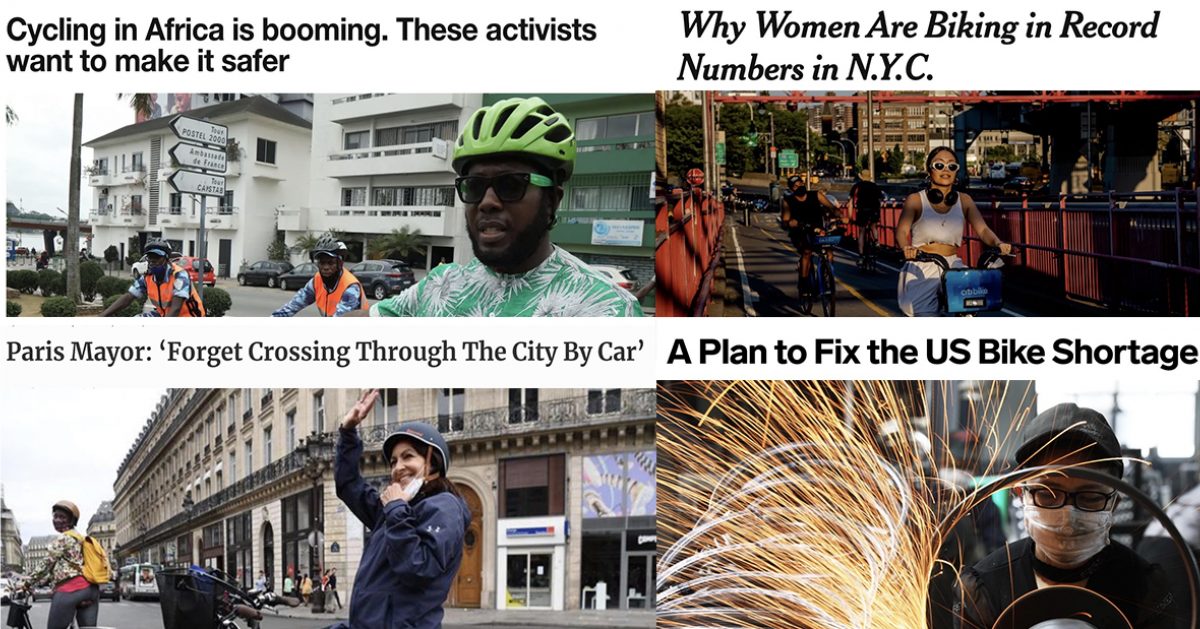
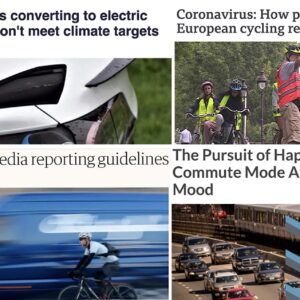
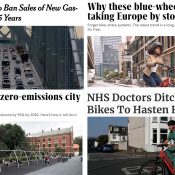
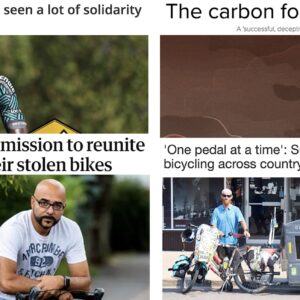
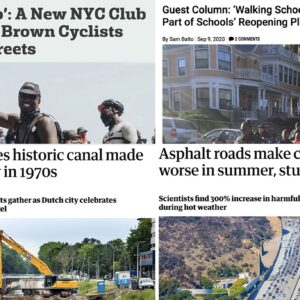
Thanks for reading.
BikePortland has served this community with independent community journalism since 2005. We rely on subscriptions from readers like you to survive. Your financial support is vital in keeping this valuable resource alive and well.
Please subscribe today to strengthen and expand our work.
Self-driving cars and self-sustaining nuclear fusion: both just 5 years away for the past 10 years! Prediction: They will both still be “just 5 years away” in another 10 years.
And yet… Waymo is confident enough in their technology that they are offering taxi service to the public with no backup driver in the vehicle. Either the technology is advancing, or they’re being very foolish.
https://carbuzz.com/news/waymo-offers-driverless-taxis-in-arizona
The way things are going we will be lucky to have regular cars in 5 years let alone Self-driving cars.
I will give you a $20 donation to a charity of your choice if the are fewer regular cars in 5 years than there are today. No strings attached — just contact me on 10-12-2025.
I will give you a chance to think twice about such a bet. after all, it was only about 10 months ago that I predicted, on this very blog, that air travel by the masses would drop dramatically.
People are likely traveling long distances much less often, but those who are traveling long distances might be driving them.
We really don’t know – just suggestions there may be an economic substitution rather than complete avoidance of the activity.
FWIW, ODOT’s Covid-era traffic results show peak afternoon traffic nearly at pre-Covid levels on many highways (on some highways they exceed pre-Covid). Morning traffic is off about 10% overall. Here’s a link to a recent report: https://www.oregon.gov/odot/Data/Documents/ODOT_TrafficReport_Oct_9_2020.pdf
It’s nice to see documentation that speeds did in fact pick up quite a bit after shutdown last March.
Thanks for that. I was thinking more in terms of air travel rather than local. I just don’t think we should be writing the epitaph for regular cars just yet.
Unless “regular cars” means gas cars. I think they will move to electric pretty fast. Not a solution to all our problems, but at least some improvement.
Fusion power has been “ten years away” since I was a kid in the 70s. Recently I heard a quip that “fusion power is the energy of the future, and always will be.” Sometimes I wonder if that will also be the case with robot cars.
At this point battery storage of renewable power is a better bet in the long run. There are an increasing number of utility scale batteries going in that don’t have the long term cost risks of nuclear power. The price of nuclear plants keeps going up but the price of solar, wind, and batteries are dropping. If you started building a 5 billion dollar fission plant today it would likely not be worth turning on when it was finished 5+ years from now due to the the costs of renewables.
I think if we can make Thorium reactors commercially viable, it won’t be such a third rail.
Now I see why they call you GlowBoy… 😉
There are some nuclear plants designated to black-start the North American grid, but despite the technology having onsite fuel, hydro plants and pumped storage facilities remain by far the most “on-demand” generation technologies we have.
The eastern Columbia River Gorge is one of the densest concentrations of wind and hydro generation in this hemisphere; no coincidence many critical datacenters are dotted along there. There’s a proposal to build a pumped storage facility at the former aluminum smelting plant near the John Day Dam – check it out sometime.
Agree with you on fission advances. I think it’s generally narrow-sighted of us as a society to position energy generation modes as “either-or” as much as we do.
Also, Peak Oil.
Basing our safety on the good will and attentiveness and sobriety of drivers is probably not going to work — we know there will always be people who just will not drive responsibly. If we’re going to reject enforcement of traffic rules, we need to embrace other strategies. Why not this?
I’m just expressing my annoyance and frustration with so many transportation professionals being distracted by the bright shiny object of AV tech when we have all the tech we need within us for the most part. I’m not against technology or pursuing these things, but IMO the distraction with them had everything to do with lacking confidence in more feasible, low-tech solutions that require more political will and change-making efforts.
Also, I think you’re mischaracterizing the enforcement thing when you say “we’re going to reject enforcement of traffic rules”. I think what people are saying is that using traditional enforcement – Cops – is no longer a good option. Enforcement is absolutely here to stay – it’s just a matter of thinking of different ways to do it.
I would totally support phasing out traditional enforcement as better tools become available. But if we eliminate it out without a plan for what comes next, we’re going to have a potentially long period during which there is little to no traffic enforcement, which will not help cycling (or walking, or even driving).
As with everything else that falls under the umbrella of “defund”, the approach is backwards. We need to design the better model first, then plan a transition to it. I know some folks here think they know what that better model is (new roads! automated enforcement!) and they may be right, but we’re still missing the transition plan that allows us to back off on traditional enforcement as these new strategies come online.
All that said, I share your frustration with planners’ infatuation with the “new shiny technology”, which I see as a counterpart to the “new shiny philosophy”.
AV technology has been, repeatedly, shown to dramatically decrease the risk of pedestrian and/or cyclist death in European trials. As a consequence of these studies, “intelligent speed assistance” will be required for all EU vehicles by 2024 and advanced “direct vision” systems will be required for all large vehicles by 2028. Moreover, unlike the shiny but empty plans and resolutions of the City of Portland, the EU actually intends to implement these reforms.
PS: And there is still an awful lot to be criticized about how many people have suffered unnecessary violent deaths due to the delayed roll out of these “bright shiny objects” in the EU.
That is good to hear. I’m all for tech like that.
From what I see, the opposite is true. And this was just a test drive, imagine if it were not piloted by a trained test operator?
It is very interesting that many people think that cars driven by machines are in the near future. But when the topic of traffic enforcement by machines ( speed cameras etc.) is brought up it is deemed some sort of impossibility enough though it is much simpler than useful widespread self driving cars.
Automated enforcement is racist, didn’t you hear?
When you are too old to drive yourself you might get a lot more interested in AV tech. It will be a lot easier to take dangerous older drivers off the road if there is a technology that can preserve a little of their independence. Not everyone lives on a bus route or wants to have to call a taxi or relative to get somewhere when their eyesight is too poor to get around themselves.
Also would make conventional transit a lot more viable. Paratransit makes up a huge share of the cost of most transit systems.
I have a feeling that argument would be rejected once racial disparities arose in who could drive and who couldn’t.
Do you mean like in Germany, which has famously rigourous driver training requirements? …And yet they still have plenty of cars around, and most people have a license. Just like here.
I would support a stricter licensing regime, but I doubt it would reduce traffic.
Is that because licensing is stricter or because Germany is smaller, has a great train system, and driving is so expensive? Outside the big cities, German driving habits are remarkably similar to American ones.
Women and the boom: “…women are expected to arrive to work more carefully dressed, which can be challenging after long sweaty rides.” That’s exactly what my friend, one of the strongest cyclists I know, told me when I looked askance at her new ebike.
Hopefully the increased numbers of women on bikes will feed back into greater safety on bikes and yet more riders. This is anecdotal but I feel that I’ve seen more people of color biking as well. More riders leads to more demand for a safer biking experience.
Also: Anne Hidalgo for Mayor!
Is the use of Strava Data for characterizing broader trends too risky given how much a niche its user base is?
The NYT article uses it for discussing COVID19 female bike adoption trends in non-NYC cities (at least in NYC it had the CitiBike data to reinforce the Strava trend.)
I’m a daily commuter and frequent joy rider. I don’t track my rides, partially because I don’t like Big Data. Also, I feel that fitness tracking is seeking approval and or bragging. I don’t know what percentage of riders my opinions reflect, but it supports the question you’re asking.
With regards to bringing bicycle component production back to the US, keep in mind that the average wage for manufacturing in China is about $5 per hour US. Are you willing to work 50+ hours a week for $5 an hour in a factory without any OSHA worker safety requirements? I’m betting not. Until then most bike parts are going to be made in a Low Cost Region. If China gets more expensive parts will be made in Vietnam. Much as people say they want to buy locally produced they really just want something that works at the lowest price possible. US workers generally only make sense for high value skilled labor like assembly of aerospace and in some cases automobiles.
My high-end Shimano and Schwalbe components are already being made in Vietnam. And well-made they are too.
Then export a US minimum wage of say $15 an hour across the world! This isn’t rocket science. In fact economics isn’t even a science, it’s a set of man made rules. Pretending that made up rules are laws of nature is what people who made the rules want you to believe.
Yet, even despite such incentives bike companies continue to sprout and grow in the US. The 90’s bike revolution was quite big here and while many companies consolidated and ended up outsourcing to Taiwan and later China, not all of them did.
That sounds great! With a minimum wage of $15/hr, no one* in Vietnam will have a job. So, of course, the Vietnamese will say “no thank you, imperialist, we’ll set our own labor policies. Working on the farm is dangerous and exhausting, and pays $2/day, so factory work at $5/hr seems pretty good to us.”
*Not literally no one, but close enough… kind of like if we set our minimum wage at $100/hr.
So everyone in Vietnam works in manufacturing exported goods? C’mon now.
According to wikipedia, it’s: “Electronics, machinery, steel, food processing, wood industry, textile, footwear, vehicle, rice, coffee, cashews, seafood, vegetable and tourism.”
But don’t believe everything you read on the Internet.
Here is a puzzle for you. As a kid in the 1970’s I had a bike from Schwinn, made by american workers at a factory in Chicago. Everyone else in my working class neighborhood in SW Portland had one also. The workers in Chicago could own homes, drive cars and put food on the table. The question is what has changed? why could we do it then when the U.S. was arguably the richest country in the world and Americans the highest paid workers? Maybe this whole offshoring thing was a con to make more money for the CEO’s and shareholders.
Bikes frames are generally considered a low-end manufacturing item – easy to make, very durable, easy entry and exit for new manufacturers, and the basic technology has been standardized since about 1900; most dual suspension designs were patented in the 1890s, over 120 years ago. Many car and aircraft companies started off making bicycles. It’s bike parts that are more tricky and require more precision engineering and careful manufacturing, something that certain Asian and European companies have always done well on with continuously evolving technology, that American manufacturers by and large abandoned for automobiles long before the 1970s. Cars simply make more money, and American’s (still) value them more. (There are still some parts made in the USA, but they are a very small part of the overall market.) The offshore thing isn’t a con – it’s an economic and market reflection of how little American’s have valued bicycles since the 1950s (if not earlier) and how much certain foreign companies and consumers value them more.
I had a Schwinn banana seat bike in 1973 which I traded up for a Schwinn Varsity 5-speed in 1979 and a Schwinn World Sport in 1982. The frames were made in the USA and I think the fenders too, but most of the parts were Japanese, as were the tires, chain, drivetrain, seat, etc. My mom owned an Alex Moulton with 17″ tires, one-speed, with rear elastomers and a front suspension fork, purchased in 1965 for $100. Most of its parts were British or Japanese. My older brothers had various imported British or European bikes with a mix of Italian and French parts. My brothers worked in our local bike shop and generally regarded American parts of that period as total garbage – the imported parts, including the (relatively cheaper) Japanese, were far superior in quality, workmanship, and durability. Even in the 1970s.
The mountain bike boom starting in about 1983 transformed the whole bike industry within 5 years: By 1988 double-butted steel frames were much lighter and stronger than 1970s Schwinns, and had exotic names like Klein, Trek, Jamis, Bridgestone, Raleigh, etc., some of which were even imported. All the parts were imported. By 1995 it was only the high-end manufactured bike frames that were made in the USA, and by 2005 nearly all frames were imports too, as is the case today.
Bicycle Industrial Complexities: I always find that advice coming from a non-bicycle publication about the bike industry, is a lot like getting weight loss advice from chronically skinny people – the advice is well-meaning, but utterly useless, fairly insulting, and based on near total ignorance. Shimano dominates not because of monopoly controls, as it has plenty of competition, but because even its cheapest models work well together, and it has outlived many of its competitors. It’s very easy to find bicycles with non-Shimano parts, even low-end bikes, as well as Shimano knock-offs. Bicycles and parts are a tiny industry that has had an unusual and rare resurgence that has plainly irked the author from Wired, who is probably having trouble getting a bike of choice, but this is at best temporary. US production was towards the end mostly made up of Huffy and Roadmaster bikes; Trek was among the first to outsource overseas. And the USA was never a major bike parts producer after the 1970s.
Trek, yuck! Pre-Trek Klein = Best Klein. Chehalis forever!
Those old Kleins were rockets but damn they were murder on the back – especially on high pressure 23mm tires.
AV: From the article, “Five years ago, as companies developing this tech talked a big game to lure talent and investment dollars, we were all more optimistic than realistic about the timeline for rolling out autonomous cars that are predictable, reliable, and as safe as possible.”
Not ALL of us. I, and I claim no genius here, have been skeptical because lane keeping and adaptive cruise control FELT like AV but were in fact a long time coming. Cruise control, already possible in the 60’s didn’t really catch on until the 80’s and it took another 30 years to take on the “adaptive” part. Lane keeping is itself pretty magical but not a hard problem to solve but if the driver has to pay attention to the vehicle just as much as if they were driving it, then what’s the point? The driver might as well be driving! It’s worse than that because you CAN”T pay attention just as if you were driving because your mind knows that you’re NOT driving. It’s impossible to do for more than a few minutes.
So the devil will be in the details. You can’t implement full AV without solving ALL of problems and that’s not going to happen anytime soon. Sorry, Elon fans, he lied to you. While current Tesla “autopilot” may feel like AV and have good stats to show for it, when it fails, it fails spectacularly in a way that no human would.
Finally, nobody seems to be talking about what AV will do to our roads. It will CLOG THEM! Why pay for parking downtown when you can send your car back to your house? Why park at work when the car can return to your house to drive your kids around to their respective events? Actual AV will turn into a horror show as every trip in a car will turn into 2 trips, a there and back and make further trips possible! You can’t double or triple roadways overnight or even a decade but that’s exactly what will be needed in the event of actual AV coming online.
Or, AVs will be fleet vehicles, used like taxis, which will probably cause an uptick in vehicle use, but, on the flipside, will dramatically reduce the need for parking. More efficient and coordinated movement, smaller vehicles, and more intelligent signals may allow greater capacity on existing roads.
Or not. It’s really early to be making predictions with any level of confidence, beyond the rather obvious statement that motor vehicles are fundamental to modern life, and AVs have the potential to transform society, for good or ill, in ways that may seem unimaginable now.
One other thing I thought of this morning: if we adopt the taxi model, we’ll need far fewer vehicles than we do today (most cars currently sit idle most of the time). That could result it lower material inputs and energy consumption (because the vehicles will be electric and therefore more efficient) to provide our mobility needs.
As so often happens, decisions we make early on will have long-term consequences.
If we can just get people to tolerate sharing a ride with a few strangers, we could have autonomous vans which act like mini busses that dynamically plan their routes to make ride sharing optimal. Maybe your van stops a couple times on the way to your destination to pick someone up, or goes a couple blocks out of the way to drop someone off, but you basically get to your destination just as fast as you would alone. And maybe only 1/4 as many vehicles are needed. This is my dream.
I believe this model (automated van pool) is the most likely future of transit; I don’t see how a fixed route, fixed schedule bus could compete with a more flexible system. Once the high cost of drivers is out of the picture, scaling the system to respond to demand is much easier.
Why couldn’t TriMet offer a service like this today with a Sprinter van and a regular driver behind the wheel?
Drivers are expensive, so TriMet couldn’t afford to do this without making the fares unreasonably high. And without a critical mass of riders, the emissions would be pretty high as well.
TriMet is expensive and fares cover a tiny fraction of operating expenses. So what is your point exactly?
Public transit doesn’t work like a profitable service and it doesn’t have to because it delivers a benefit that far surpasses its cost to the serviced area. EVERYONE benefits.
To quote the most recent TriMet budget, “In FY2021, the revenue TriMet forecasts from fares covers approximately $62.4 million in current annual operating costs, or 8.5% of our operating expenses”
That’s 8.5 PERCENT! Read that again! Now, read it again!
My point is that TriMet does not have infinite money to spend and needs to pay some heed to fiscal reality.
BA, the reason point-to-point van service can’t be offered to regular customers by TriMet is because of federal law and restrictions. Such service is currently offered for ADA (disabled) customers per ADA laws (called Lift or dial-a-ride service) in which customers are charged no more than twice what a fixed-route (bus) customer would pay, with us taxpayers picking up the difference. But for regular able-bodied customers, TriMet is required to only offer urban fixed-route service, so as to not compete with commercial taxi services, but also to replicate past trolley services of times long ago. As long as TriMet wants to continue to receive federal subsidies, it has to abide by federal rules, no matter how nonsensical they might seem.
There are in fact public rural bus services that are allowed and even encouraged by the feds to have adjustable routes that pick up and drop off regular customers using both vans and buses, but for some reason they are only allowed in rural areas. There are also a very few urban public bus systems that don’t ask for nor receive federal subsidies, who do in fact have urban van taxi service like what you describe, but they are few and far between.
Another option that very few cities have done, is to offer a public subsidy for private taxi rides, based on mileage, type of passenger, type of vehicle, etc.
HK, The biggest costs for most public transit agencies is typically personnel, including drivers, dispatch personnel, customer service, and mechanics (wages, benefits, pension, training, etc., higher if unionized); the vehicles themselves (feds pay 83% of costs but with lots of restrictions and are painfully slow in the process – it’s sometimes cheaper and much easier to buy directly from manufacturers); administrative overhead and rent (bureaucratic salaries, but also planning, scheduling, etc); fuel; parts; bus stops. Cities with fixed rail/subway service like Portland or DC are very untypical – the costs for rail maintenance are substantial and require an additional layer of bureaucracy and contracts – it’s a bit like having two parallel public transit agencies in the same building. Theoretically all the personnel could be replaced with robots and/or automated services, including the management (with A.I.) But would we do it? And would the unions and feds allow it?
Some traffic in congested areas consists of people cruising for parking spots. Car storage is kind of a waste of real estate (although private cars would have to park somewhere eventually). I can hope that if we are going towards purpose-built AVs they will be smaller, lighter and have modest power to weight ratios and very low fuel consumption of whatever sort. I can also hope for single payer health care and whiskey springs.
It’s unfortunate that the League of American Bicyclists has to distance themselves from law enforcement. Clearly there’s too many cases of “biking while black” and that is an example of too much enforcement. Then you have a BMW driver who literally runs over a cyclist, not five feet from police officers, and nothing happens. So, we need more enforcement. What I foresee is people using this as a piece of evidence to say that traffic enforcement doesn’t make the streets safer for cyclists. When in reality it says, corrupt policing is bad for everyone.